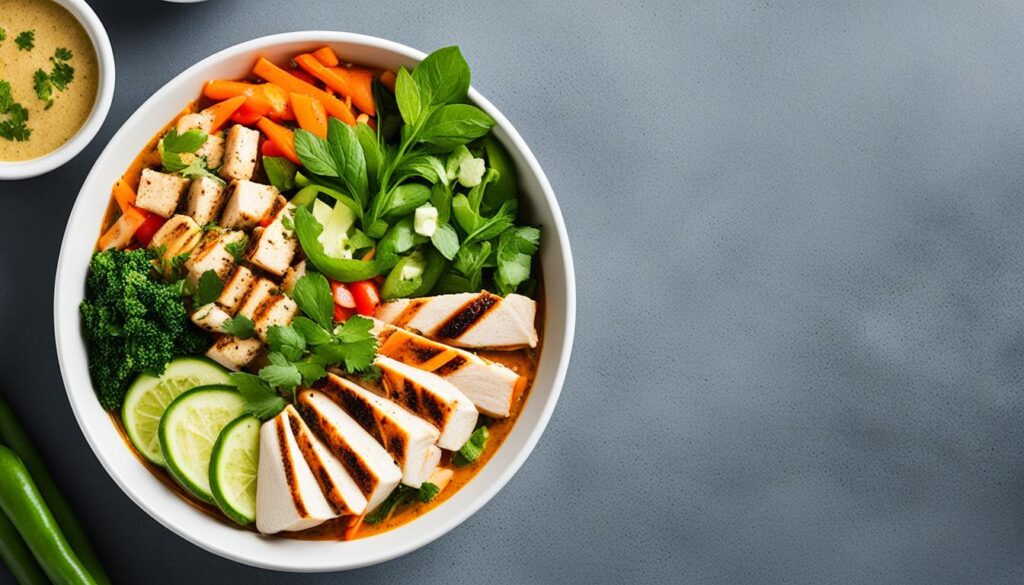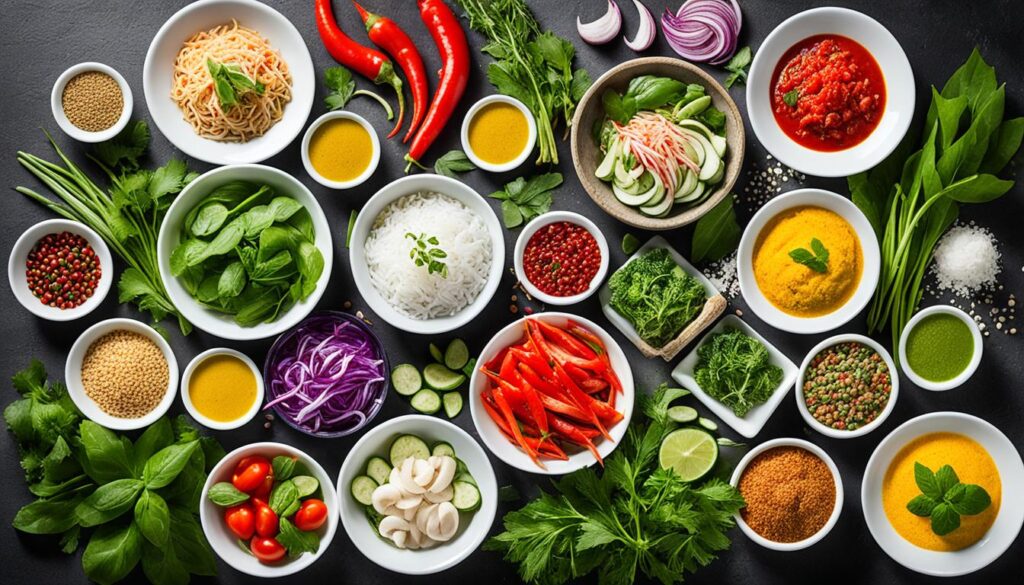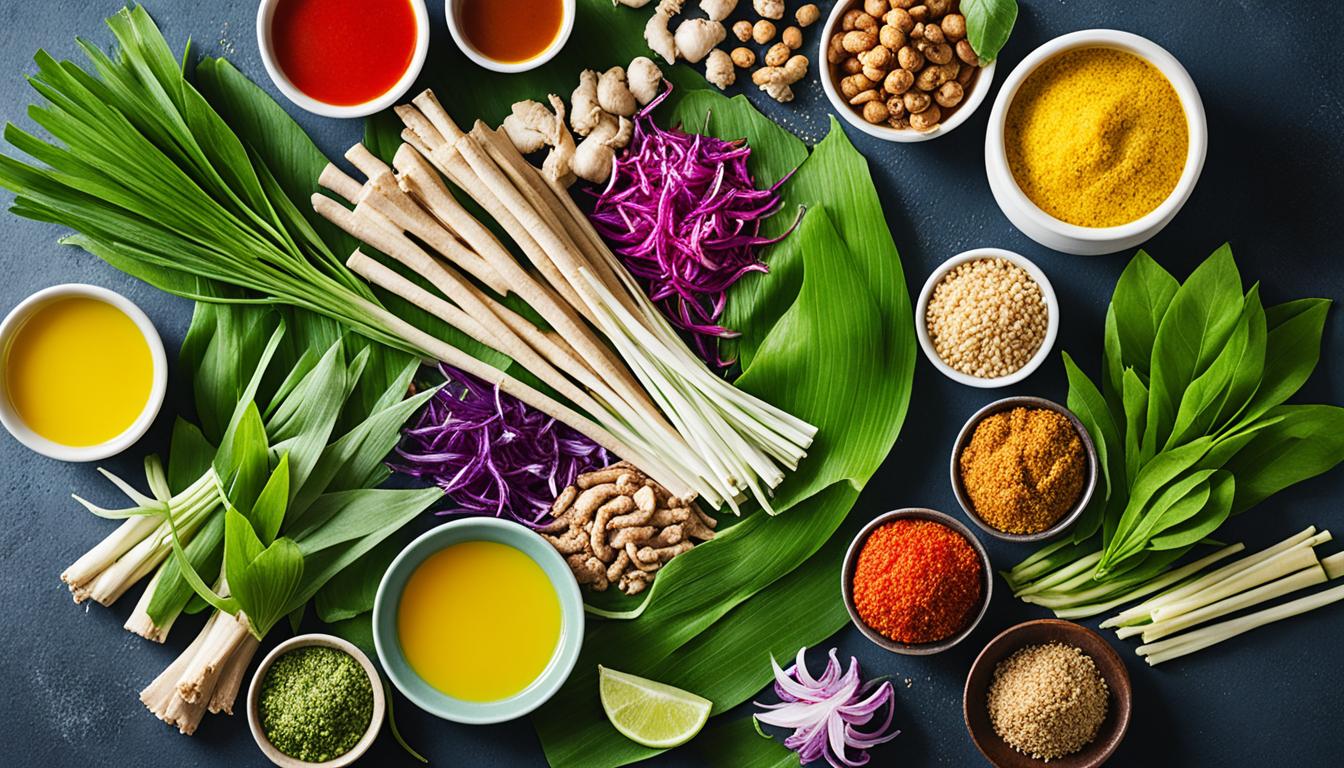Thai food offers an explosion of flavors and a vibrant culinary experience. But have you ever wondered how to build a balanced meal when ordering and cooking Thai food? Are you curious about the nutritional value of your favorite Thai dishes?
In this comprehensive guide, we will delve into the secrets of creating a well-rounded and nutritious Thai meal. Whether you are dining in a restaurant or trying your hand at cooking Thai cuisine at home, we’ve got you covered. Get ready to uncover the hidden gems of Thai food nutrition and learn how to make smarter choices for a balanced meal.
So, how can you create a meal that is not only delicious but also nutritious? How can you make your Thai dining experience more than just a feast for the taste buds? Join us as we explore the art of ordering and cooking Thai food, and discover the key to building a balanced Thai meal that will leave you satisfied in body and soul.
Thai Food Culture: The Basics of Eating in Thailand
In Thailand, food is available everywhere, from busy city streets to remote areas. Bangkok and Chiang Mai are renowned for their diverse food options, but you can find delicious meals throughout the country. Thais eat all types of food at any time of day, so you’ll never go hungry. It’s common to find street stalls, fruit shake stands, and convenience stores offering a variety of options. Traditional Thai meals often include a combination of flavors and textures, with dishes served family-style alongside bowls of steamed rice.
Thai food is known for its vibrant and aromatic dishes that incorporate a wide variety of ingredients. From fragrant herbs and spices to fresh vegetables and succulent meats, Thai cuisine offers a diverse range of flavors that can be tailored to suit different palates and dietary preferences.
One of the key elements of Thai food culture is the tradition of family-style dining. This means that dishes are typically shared among a group of people, allowing everyone to taste a variety of flavors and textures. The dishes are served alongside bowls of steamed rice, which acts as a staple in Thai cuisine.
When it comes to meal planning, Thai cuisine offers a multitude of options to create a healthy and balanced meal. By incorporating a mix of protein, vegetables, and carbohydrates, you can customize your Thai meal to meet your nutritional needs.
Here are some Thai food ingredients that you can include in your meal planning:
- Fresh herbs and spices: Thai cuisine often utilizes aromatic herbs and spices such as lemongrass, basil, cilantro, ginger, and garlic to add flavor to dishes.
- Vegetables: Incorporate a variety of colorful vegetables like bell peppers, broccoli, carrots, and bok choy to enhance the nutritional value of your meal.
- Protein sources: Choose lean protein options like chicken, shrimp, tofu, or fish to provide essential nutrients.
- Rice and noodles: Opt for whole grain rice or noodles for a healthier carbohydrate source.
- Healthy fats: Use coconut milk, avocado, or nuts sparingly to add richness and flavor to your dishes.
By being mindful of your ingredient choices and portion sizes, you can enjoy a delicious Thai meal that is both satisfying and nutritious. With the abundance of flavors and ingredients available in Thai cuisine, meal planning becomes an exciting and enjoyable process.
How to Order Thai Food in Thailand
When it comes to ordering Thai food in Thailand, navigating the menu and understanding the ordering process can be a delightful adventure. With a few tips in mind, you can easily build a nutritious Thai meal and make healthy choices. Here are some pointers to help you order the perfect Thai feast:
- Choose your protein: Most Thai dishes offer a variety of meat options, including pork, chicken, shrimp, seafood, or beef. When placing your order, simply state the dish you want followed by the type of meat you prefer.
- Customize based on preferences: Thai cuisine is known for its versatility, allowing for various additions and alterations to suit individual tastes. You can explore additional options such as adding a fried egg or specifying the spice level, but these are not necessary to enjoy a delicious meal.
- Spice it up or tone it down: Thai cuisine offers a range of spice levels, from mild to fiery hot. If you prefer milder flavors, you can request dishes to be less spicy (“mai pet”) when placing your order.
- Self-serve or table service: Street stalls and smaller Thai restaurants typically operate on a self-serve system. You order and pay upfront, then find a seat and wait for your order to be prepared. On the other hand, larger restaurants offer table service, where you can sit comfortably while the staff takes your order and brings it to your table.
To have a memorable dining experience, don’t be afraid to ask for recommendations and try new dishes. Thai cuisine is rich in flavors, and exploring the diverse menu options will help you discover new favorites. Whether you’re dining at a street stall or a high-end restaurant, ordering Thai food in Thailand is an adventure for your taste buds.

How to Eat Family-Style in Thai Restaurants
Eating family-style is a common practice in Thai restaurants, allowing groups to share and enjoy a variety of dishes together. This style of dining not only fosters a sense of community but also provides an opportunity to taste a wide range of flavors and textures. To create a balanced and satisfying meal in a Thai restaurant, we recommend selecting a diverse combination of dishes.
When ordering, consider choosing a stir-fried dish for its savory flavors, a vegetable dish to add freshness and nutrients, a soup to warm the palate, and a fish or seafood dish to incorporate lean protein. Each person can then help themselves to a small portion of each dish, combining it with a scoop of steamed rice. This approach ensures that everyone can enjoy a well-rounded meal that caters to their individual taste preferences.
By sharing and sampling different dishes, you can explore the rich culinary traditions of Thailand and discover new flavors that complement each other. It’s an excellent opportunity to enhance your dining experience and appreciate the diversity of Thai cuisine.
Insert some captivating, relevant text alongside the image, such as “Sample the vibrant flavors of Thai cuisine by sharing a variety of dishes family-style in a Thai restaurant.“
Spice Level in Thai Cuisine
Thai cuisine is known for its vibrant flavors and unique combinations of spices. One important aspect of Thai cuisine is the spice level, which can range from mild to very spicy. Understanding the spice level in Thai dishes can help you make healthy choices and enjoy your meal to the fullest.
Some dishes in Thai cuisine are traditionally spicy, such as som tam (green papaya salad), phad grapao (stir-fried chilies and basil), and tom yum (spicy soup). These dishes are packed with bold flavors and can provide a fiery kick to your taste buds.
On the other hand, dishes like fried rice, phad thai, and basic noodle soups are typically not cooked with chilies and are milder in flavor. These dishes offer a more subtle taste profile while still showcasing the signature Thai flavors.
If you prefer milder flavors or have a low tolerance for spice, you can request dishes to be less spicy (“mai pet”) when ordering. Thai chefs are often accommodating and can adjust the spice level according to your preference.
When exploring Thai cuisine, it’s important to consider your spice tolerance and make choices that align with your taste preferences. Whether you enjoy the fiery heat of Thai spices or prefer a milder experience, there are plenty of delicious and healthy Thai food choices available.
Key Points:
- Thai cuisine offers a range of spice levels, from mild to very spicy.
- Traditionally spicy dishes include som tam, phad grapao, and tom yum.
- Milder dishes like fried rice and phad thai are not cooked with chilies.
- You can request dishes to be less spicy (“mai pet”) when ordering.
Street Food vs. Restaurants in Thailand
When it comes to experiencing the vibrant flavors of Thai cuisine, you’ll have the option to indulge in the delicious offerings from street stalls or dine in restaurants. Each option offers a unique dining experience, catering to different preferences and budgets.
Street Stalls: A Taste of Authenticity
Street stalls are an integral part of Thai culture, offering an authentic and immersive culinary experience. Operating on a self-serve system, these stalls allow you to interact directly with the cook and witness the cooking process. You can simply tell the cook what you want, find a seat, and eagerly await your freshly prepared dish.
Street stalls are known for their wide range of affordable and flavorful Thai delicacies. From aromatic noodle soups and fiery stir-fried dishes to mouthwatering grilled meats and tropical fruit shakes, there’s something to satisfy every palate. Plus, street food often allows for customization, with additional toppings and condiments available.
While some street stalls provide free drinking water to accompany your meal, others may offer bottled water at an additional cost. It’s important to stay hydrated as you explore the delectable street food scene in Thailand.
Restaurants: Comfort and Table Service
For those seeking a more familiar dining experience, Thai restaurants provide a comfortable and relaxed atmosphere. You’ll find a diverse range of restaurants throughout Thailand, ranging from casual eateries to upscale establishments.
Unlike street stalls, restaurants in Thailand follow a conventional ordering process. Friendly staff members are available to assist you in selecting dishes and provide table service throughout your meal. This allows you to sit back, relax, and fully immerse yourself in the culinary journey.
Thai restaurants offer an extensive menu, featuring a wide variety of dishes that showcase the rich flavors and intricate techniques of Thai cuisine. From classic curries and aromatic stir-fries to refreshing salads and delicate seafood preparations, there’s no shortage of options to tantalize your taste buds.
When dining at a restaurant, it’s essential to choose reputable establishments that prioritize hygiene and use fresh ingredients. Look for restaurants that are clean, have positive reviews, and are known for their high-quality Thai cuisine.
Whether you choose to savor the vibrant street food scene or enjoy the comforts of a restaurant, ordering healthy Thai food and cooking balanced meals is achievable in both settings. With an abundance of fresh ingredients and a culinary heritage that celebrates a harmonious blend of flavors, Thai cuisine offers endless possibilities for nutritious and satisfying meals.
Considerations for Dietary Restrictions in Thailand
If you have dietary restrictions, we understand that finding suitable options can be a concern when traveling to Thailand. However, rest assured that it is possible to enjoy delicious Thai cuisine while catering to your specific needs. Here are some helpful tips to navigate dietary restrictions and make informed choices:
1. Research and Communicate
Prior to your trip, do some research on restaurants or food stalls that offer options suitable for your dietary restrictions. This will help you feel more confident and prepared. Additionally, communicate your needs clearly to the staff or chef to ensure that they understand your requirements.
2. Vegetarian and Vegan Options
Thailand is known for its abundance of fresh fruits, vegetables, and plant-based ingredients. Many restaurants and street food vendors offer vegetarian and vegan dishes, making it easier to find suitable options. However, it’s always a good idea to double-check ingredients to avoid any hidden animal products.
3. Gluten-Free Awareness
If you follow a gluten-free diet, you can still enjoy Thai cuisine. While dishes like noodles and stir-fries may contain gluten, there are gluten-free alternatives available. However, be cautious of soy sauce, as it often contains gluten. When ordering, ask about the use of gluten-free soy sauce or request dishes without soy sauce to ensure your gluten-free needs are met.
4. Allergies and Ingredient Inquiries
If you have severe allergies, it’s crucial to inquire about ingredient details and cross-contamination risks. Speak directly with the staff or chef to understand how dishes are prepared and whether they may come in contact with allergens. By asking detailed questions, you can make an informed decision and prioritize your safety.
5. Seeking Local Recommendations
Locals and fellow travelers can offer valuable insights and recommendations for restaurants or food stalls that cater to specific dietary needs. Online forums and travel communities are excellent resources for gathering information about reliable establishments. Don’t hesitate to seek advice from those who have already explored the local food scene.

When exploring Thai cuisine with dietary restrictions, being proactive, and conducting thorough research will help you savor the flavors of Thailand without compromising your dietary needs. Don’t be afraid to ask questions, seek recommendations, and enjoy the diverse and vibrant food culture that Thailand has to offer.
Choosing a Reputable Thai Restaurant in Mornington
When it comes to enjoying a delicious and healthy Thai meal, choosing the right restaurant is essential. Mornington offers a variety of Thai dining options, but it’s important to consider several factors before making your decision.
Firstly, convenience is key. Look for a restaurant that is conveniently located for you and your companions, making it easily accessible. Adequate parking facilities should also be available to ensure a hassle-free dining experience.
The ambiance of the restaurant plays a significant role in your overall dining experience. Opt for a Thai restaurant in Mornington that provides a pleasant and welcoming atmosphere. This will enhance your enjoyment of the meal and create a memorable experience.
Professional and efficient service is another aspect that shouldn’t be overlooked. Choose a Thai restaurant with a reputation for delivering excellent customer service. Prompt and attentive service adds to the overall satisfaction of your dining experience.
Hygiene is of utmost importance when it comes to selecting a restaurant. Prioritize cleanliness and hygiene standards by choosing a Thai restaurant that maintains a clean and sanitary environment throughout. This ensures the quality and safety of the food you will be consuming.
Speaking of food, the quality of the dishes is crucial. Look for a Thai restaurant in Mornington that specializes in serving delicious and healthy Thai cuisine. Seek out establishments that focus on using fresh ingredients and offer a variety of nutritious options on their menu. Whether you have specific dietary requirements or simply want to make healthier choices, a reputable Thai restaurant will cater to your needs.
Lastly, to ensure you’re getting the best value for your money, it’s a good idea to compare prices among different Thai restaurants in Mornington. While price shouldn’t be the sole determining factor, finding a restaurant that offers good value for money can enhance your dining experience even further.
So, when it comes to choosing a reputable Thai restaurant in Mornington, consider the location, ambiance, service, hygiene, food quality, and prices. By taking these factors into account, you can enjoy a delightful and nutritious Thai meal that satisfies your cravings and nourishes your body.
The Benefits of Meal Prep in Indian Kitchens
Meal prep has become increasingly popular in Indian kitchens as a convenient and budget-friendly way to ensure nutritious meals. By planning and preparing meals in advance, you can save time for other activities and reduce the stress of daily cooking. This approach involves prepping ingredients, making masala pastes, and storing meals for later use, creating a streamlined cooking process.
One of the key benefits of meal prep is better portion control. By pre-portioning your meals, you can avoid overeating and maintain a balanced diet. This is especially important when it comes to Thai food, as portion sizes can sometimes be larger than necessary. With meal prep, you have complete control over the amount of each ingredient, allowing you to create well-balanced and nutritious Thai meals.
Meal prep also offers the flexibility to accommodate various dietary needs. Whether you’re following a specific diet plan or have dietary restrictions, meal prep allows you to customize your meals accordingly. You can choose the right ingredients, modify recipes to fit your dietary requirements, and ensure that you’re getting the necessary nutrients from your Thai dishes.
Overall, meal prep is a fantastic way to maintain a healthy and balanced diet while still enjoying the delightful flavors of Thai cuisine. It allows you to save time, control portion sizes, and adapt your meals to meet your specific nutritional needs. So why not give meal prep a try in your Indian kitchen and experience the benefits it offers for Thai food meal planning and balanced Thai food recipes?
